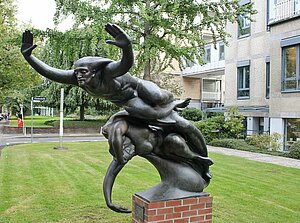January 30, 2018
1980s

The most famous sculpture in connection with the Heinrich-Hertz-Institut is the bronze statue “Ether Wave”, which can be admired on the premises of the NDR in Hamburg. The idea for the monument was born in 1931, but the project was on hold for over 50 years. It was not until the 1980s that the sculpture was completed in honor of Heinrich Hertz.
Communications engineering and art may be a rather untypical combination, but there have always been points of contact between the Heinrich-Hertz-Institut and works of art. After the farewell of Dr. Ohnsorge in 1980, Dr. Wolfgang Grunow became the sole managing director of the Institute. With his entrance, art became more important at the Institute. The jurist with a doctorate in law always endeavored to introduce the institute’s staff to the fine arts, during his two-year term of office. This venture proved to be difficult at times, as he had to deal with rather rational scientists who regarded some of his initiatives somewhat mockingly. Dr. Grunow was administrative director at the Institute from 1977 to 2002.
Nevertheless, Dr. Grunow arranged for exhibits to be on display in the reception hall, in event rooms and in the hallways of the Institute. Since 1986, the sculpture "Grau Broby Granit" by sculptor Ulrich Rückriem has been located in front of the Einsteinufer building. The artist from Düsseldorf produced the six-metre-high block in Broby, Sweden, as the name already reveals.
Another remarkable work of art associated with the Heinrich-Hertz-Institut has an older history: the bronze statue "Ether Wave", which is located on the premises of the NDR in Hamburg. The broadcasting corporation NDR wanted to create a memorial to Heinrich Hertz together with the Hamburg Senate as early as 1931 to honor the scientist, who was born in the Hanseatic city in 1857. The sculptor Friedrich Wield was commissioned to create the bronze sculpture "Ether Wave". When the National Socialist Party came to power, he had already completed the plaster mold, but the construction of a monument devoted to Hertz was forbidden because he was a Jew. The project was resumed in the 1980s. The sculptor Manfred Sihle-Wissel was commissioned by the City of Hamburg to complete the sculpture from the original print. Initially the “Ether Wave” was exhibited on the banks of the Alster in Eichenpark, but can be admired at its current location since 2016.
Regular exhibitions contribute to the fact that art is still plays an important at Fraunhofer HHI.